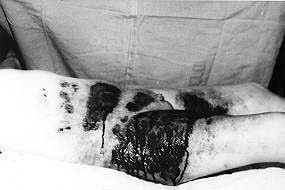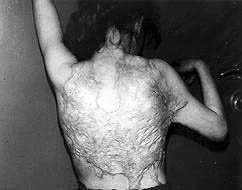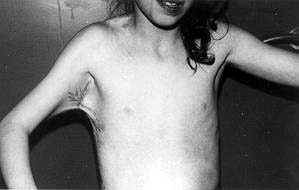Annals of
Burns and Fire Disasters - vol. XII - n° 2 - June 1999
NEVER TOO LATE? BURNS AND FUNDAMENTALISM
Raveh 1, Eldad A.
Department of Plastic Surgery, Burn
Unit, Hadassah Medical Centre, Ein Kerem, Jerusalem, Israel
SUMMARY. This
article considers how inadequate treatment may aggravate burn wounds. Two case histories
are presented. Sometimes surgical treatment is recommended by a patient's physician but
opposed by the family's religious adviser. It is recommended in such cases that there
should be meetings with the counsellor so that the consequences of purely conservative
treatment may be fully appreciated.
Introduction
Burn wounds can be
aggravated by the wrong treatment, early hospital discharge, opposition to surgery in
cases of deep burns, and treatment by inadequately trained personnel. Almost every month
we face cases of patients who on the instructions of their religious advisers refuse to be
treated in hospital or an out-patient clinic.
This article is dedicated to all burn patients - and their families - who owing to
ignorance and the advice of nonmedical counsellors have suffered an aggravation of their
injuries, i.e. patients whose treatment has been delayed, with an outcome that was less
successful than might have been expected.
We present two extreme cases out of the many treated in our department.
Cases
A plastic surgeon usually
treats a burn patient immediately after the burn event. In some cases there is a delay in
the referral of a patient, who as a consequence arrives with advanced and neglected burns.
Case 1. R.S., an
8-year-old boy with 32% 2nd- and 3rd-degree burns, was admitted to the emergency room,
after conservative treatment, with 13% open burn, hypergranulation, contracted scar in the
knee (Fig. 1), and disturbed laboratory values: pt = 43%, inr = 2.73, vitamin k
deficiency, leukoeytosis (23,500), thrombocytosis (902,000), hypoalburninaemia (21 g/1).
The wound was infected with Candida albicans, Candida tropicalis, Pseudomonas, and Acinetobacter
caluoace. Several days after hospitalization the patient developed a sepsis due to Candida
infection. The child's hospitalization lasted 6 weeks, during which he twice underwent
skin grafting.
 |
Fig.
1 - Open wound in thigh and abdomen in child treated at home for 8 weeks. |
|
Case 2. P.H.,
a 10-year-old girl, came to our out-patient clinic for consultation regarding a one-year
old post-burn scar. The child had been hospitalized for a short term after the burn but
left hospital without any surgical treatment.
The result of this second- intention healing scar is shown in Figs. 2 and 3. The patient
underwent contracture release and skin grafting in the open wounds.
 |
 |
| Fig. 2 - Second-intention healing
after hot-water burn, with contracted scar permitting only 45° abduction movement of the
shoulder. |
Fig. 3 - Same patient, anterior view. |
|
Discussion
Deep burn wounds will
create a scar following secondintention healing processes, but the deeper the burn the
greater the chance of hypertrophic, keloid, and contracted scars.
Delay in wound healing can be due to systemic or localized conditions, and the best
results are achieved through early detection of complications and early grafting of deep
2nd-degree burns.
For these reasons a follow-up by medical staff is mandatory.
We have witnessed cases in which an operation was recommended but the family's religious
counsellor decided on conservative treatment, with disastrous results.
We therefore recommend meetings with such counsellors, if possible, in order to explain
the possible consequences of delay or home treatment, using pictures of previous cases.
The most important thing for us is to disregard our ego and to understand that in all
religions there are people who will obey their advisers and not our recommendations.
Nevertheless, always leave an open door for these patients so they will not be too
embarrassed or afraid to return.
RESUME. Les
Auteurs considèrent les conséquences négatives du traitement inadéquat des brûlures
et présentent deux cas spécifiques.
Quelquefois le médecin conseille le traitement chirurgical, mais le conseiller religieux
du patient s'y oppose. Dans ces cas il faut
organiser des rencontres avec le conseiller pour expliquer clairement toutes les
conséquences possibles du traitement uniquement conservateur.
BIBLIOGRAPHY
- Robson M.C., Barnett R.A., Leitch OW. et
al.: Prevention and treatment of post-burn scars and contracture. World J. Surg., 16:
8796, 1992.
- Robson M.C.: Disturbances of wound healing.
Ann. Emerg. Med., 17: 1274-77, 1998. 3. Krizek T.J.,
- Robson M.C., Kho E.: Bacterial growth and
skin survival. Surg. Forum, 18: 518-20, 1967.
- 4. Larson D.L., Abston S., Evans E.B. et
al.: Techniques for decreasing scar formation and contractures in the burned patient. J.
Trauma, 11: 807-23, 1971.
| This paper was
received on 5 March 1999. Address correspondence to:
Dr Tamrar Raveh, M.D.
18 Benyamini St., Tel Aviv 67443, Israel. |
|


